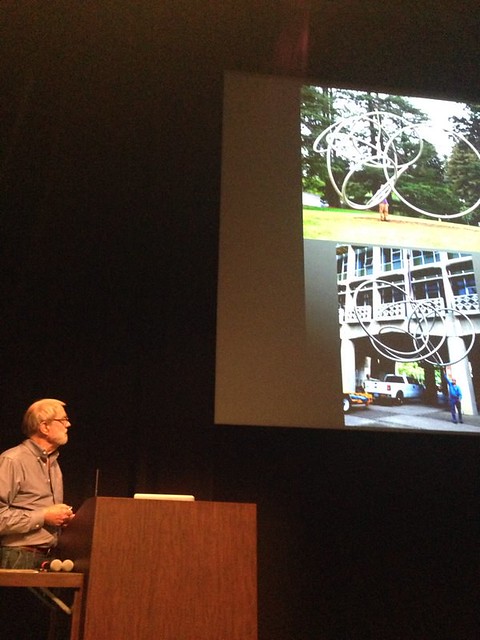Revisited: "Change and Stillness: Bodies and Gestures within Sensor Technology"
Last Friday, four wonderful presenters came together to present two sessions showcasing the multidisciplinary art processes happening at Cal. All the projects integrated sensor technology.
Cal students are very familiar with Bruce Beasley’s Rondo sculpture near the VLSB on campus. The graceful rings are evocative and lend interest to the grassy plaza. His sculptures are being choreographed by this year’s Berkeley Dance Project as a series of large-scale projected rings.
Each hour and a half session combined talk, live demonstration and some audience interaction with the technology.
The session began with an introduction to the history of sensor technology development here at Berkeley. The greatest benefit was that the technology was never patented allowing a full range of potential uses to develop. The inventor says it’s incredibly gratifying to see grad students pick up the project and see it thrive in unexpected directions. His next project is in small particle sensing in the atmosphere. He wants this newest project to develop into an inexpensive way for everyday people to make informed interactions with the air in their daily life.
The talk continued with a discussion on sensors embedded in musical instruments. The experimentation process revealed a number of interesting data groups that occurred from this integration. These arrays were integrated into Roberto Morales-Manzanares’s prizewinning audio-visual piece “Cenzontle”.
One of the major obstacles for the use of this sensor technology was that both the human body and a guitar are curved surfaces. This required further research into sensor surfaces that could curve, like fabric. No one knew how to do it, so naturally, UC Berkeley offered a class on it. By the end of the semester, a master weaver had caught onto the trend and produced a weave that integrated the sensitive fibers so that the conductive parts never intersected. This technology can sense many inches off a surface - allowing for interesting applications in wall hangings and dance surfaces.
The talk ended with a live demonstration of the Rondo dance piece. Originally, multiple complicated sensor technologies were developed until they landed on an extremely simple solution. By strapping an iPhone or iPod to the dancer’s chest, the accelerometer and and gyroscope would affect the orientation of the projected rings. The movement in space was joystick controlled by an unseen actor above the audience.
The real beauty of the project comes from the simplicity and imperfection of the data, there are only two data streams coming in. It’s a duet between the dancer and the joystick controller, where both make improvisations based on the music and movement. And there is a level of intimacy, since the sensors capture subtle changes like the dancer’s breath that aren’t visible to the naked eye.
The session ended with the presenters allowing the audience to come up and interact with the materials and technology and ask questions.
To learn more about some of the technology, visit TDPS, CNMAT or Kobakant online!
This event was sponsored by: ARC | Arts + Design, TDPS, Cal Performances, BCNM, CNMAT and Music and Art Practice.

